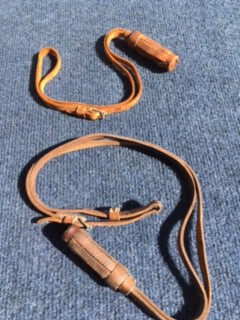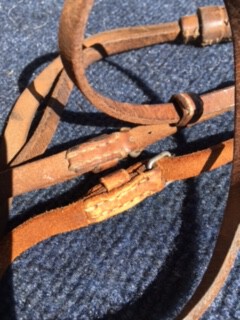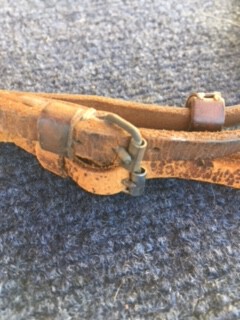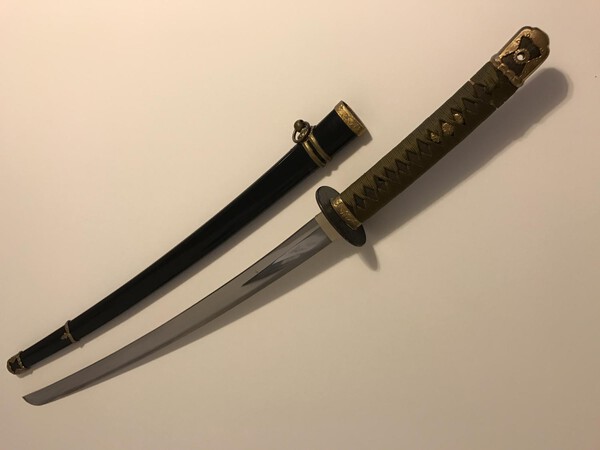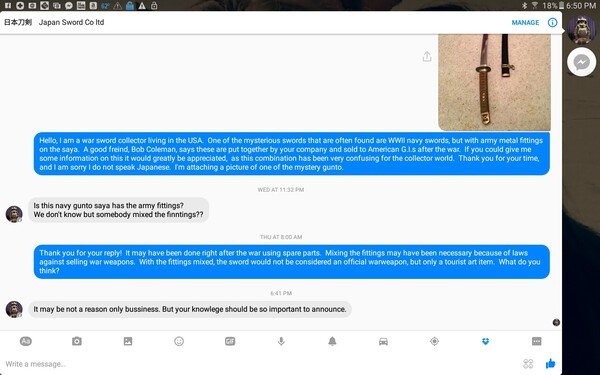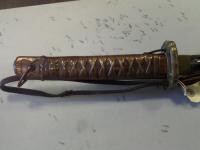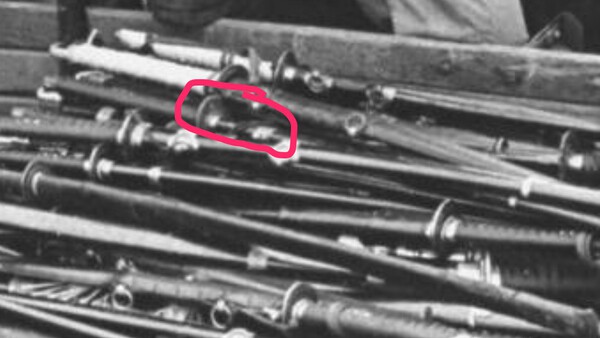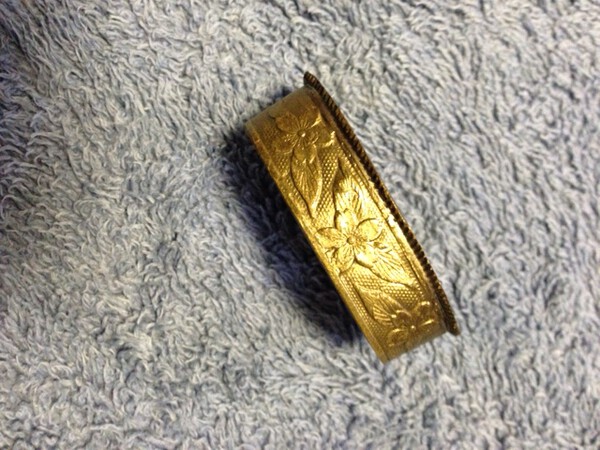-
Posts
12,848 -
Joined
-
Last visited
-
Days Won
154
Content Type
Profiles
Forums
Events
Store
Downloads
Gallery
Everything posted by Bruce Pennington
-
Scored 2 NCO leather tassels from eBay! All I need is one more, without tassel to deck-out my Type 95 collection. One is clearly shorter than normal, at 11 inches. Someone speculated that it looked like it might have been broken and re-stitched. I concur. The stitching looks legit and it only has 1 buckle-hole vs the 3 on the one of standard length. Pics below. They are both old and fragile, though the long one is darker and appears to have been coated with a leather oil. It is still fragile and shows cracks when you bend it. The one from China worried me. I could have sworn it was coming from Japan, but when the package arrived, it was from China! After close examination, it is clearly legit. So just backs up someone's statement that there are true collecters in China too
-
Patryn, It would help to have a better pic of that bottom kanji. I'm a complete novice, but aren't the top 2 kanji the province Yasa shiro? The "yasa" is obvious, but the second kanji is pretty poor if it is "shiro".
-
Tony, the guys that translate don't always come by this forum as often as the does the "Translation Assistance" forum. Here's the link if you want to post it there http://www.militaria.co.za/nmb/forum/15-translation-assistance/
-

Unusual Translation Need!
Bruce Pennington replied to Bruce Pennington's topic in Translation Assistance
Thanks Jay! I thought I would just continue the conversation on Messenger, but in Japanese. I'll get you my question below. If you post the Japanese version, I'll copy and paste into Messenger. When they reply, I'll bring it back here for you to translate back into English. Here goes: "Thank you for your answer. We know of some gentlemen who bought swords like this from The Japanese Sword Company after the war. Is it possible to find out whether the Company, after the war, found the swords already assembled in this way,and sold them, or if they used surplus parts and had them assembled as souvenirs? There are many collectors who truly appreciate Japanese swords, even the war swords, and would love to learn more about this particular style." Please feel free to rearrange, or rephrase, as necessary for language or custom needs. Again, THANK YOU! -
Fellow Collectors, I tried to contact The Japanese Sword Co. via Facebook Messenger (they don't list an email on their website) and got a response, but it was confusing, no doubt, due to translation issues. I don't speak Japanese and their English speaker (maybe computer translation?) needs work! I'm looking for someone who can take my request, written in English, and write it out in Japanese. Then when they respond, translate their response back to English for me. Just to let you know what I'm doing - Many of you are familiar with the mystery gunto often called a "Marine Landing Sword" or "Navy Landing Sword." They are Toyokawa arsenal blades with Navy black canvas same' and black saya, but fitted with gold-gilded ARMY metal fittings. Fuller & Gregory mentions these gunto and offer several ideas, but it is their opinion that they were post-war assemblies. I recently got a tip from another forum member that he bought 4 of these from former G.I.s who said they bought them from The Japanese Sword Co. in Tokyo shortly after the war. I wrote to the Company, asking if this were true, speculating that they were allowed to assemble non-regulation arrangements, thereby getting around the prohibition to sell war weapons, and the MacArthur regime permitted it to keep business and craftsmen going. Their response was "It may not be a reason only business. But your knowledge should be so important to announce." That SOUNDS to me like they are acknowledging the fact (the first part seems to say that my reasoning for the sale is off?). If true, this would be HUGE for those of us who collect war swords! If anyone can help me with this, please respond here or via PM! I would like to confirm their answer in Japanese and get a clarification - Did they assemble the parts, or were the gunto fully assembled already when they got them? The latter would indicate that they were war-assembled for the war, the former would mean they are souvenirs made by surplus war parts. Thanks in advance for your help!
-
Interesting idea Trystan. Have a close look at the tassel on this copper-handled 95 that Matt mentioned. It just sold for almost 5,000 USD, and the tassel is only 11 in. long and appears to have a rivet or tiny bolt holding the severed ends together. http://www.militaria.co.za/nmb/topic/22507-copper-handle-nco/ (sorry the pic I copied off the thread is blurry. You can get a better look at it from the thread above)
-

One Of Those "mystery" Swords
Bruce Pennington replied to jeep44's topic in Military Swords of Japan
Steve, the seller clearly doesn't know what he is talking about! My impression of this one is of a civilian blade pressed into service during the war. The very loose fit at the fuchi makes it appear to be missing several seppa, too. -

One Of Those "mystery" Swords
Bruce Pennington replied to jeep44's topic in Military Swords of Japan
Stephen, I don't understand the meaning of this link. -

Minamoto Sadayuki's Wild Hada
Bruce Pennington replied to tokashikibob's topic in Military Swords of Japan
Wow, Bob, quite a piece! Such a unique saya covering, too. -
It's beautiful! I see nothing but a great looking Type 95, copper-handle gunto that's probably going to cost you, but it's worth it!
-

Company Officers Parade Sabre W/box
Bruce Pennington replied to Kwakernaak's topic in Military Swords of Japan
Peter, Very nice find!!! Dawson, pg 63, calls that pattern one of a company grade kyu-gunto. Whether it's a Type 19 or not, someone with more experience with these will have to comment. Dawson, page 416-417, shows the belt buckle and blue backing as a company grade officer as well. I have no experience with these, though, and others will have to answer your questions about the box and translation. -
Poor guy didn't know how to mount the NCO tassel, but with that as the only image, seems proper. Wonder if he'd sell me that tassel!!!
-
Greg, I'm not familiar with a Mantetsu blade marked "Mantetsu Kitae Tsukuru Kore". Do you have an example? I have read that Mantetsu's not labeled "Koa Issin" were made in Tokyo, but I don't know that for a fact. Like Ohmura-san said at the end of the article posted by Dave, he didn't know the difference in quality of the 3 types, so I don't know how one would value one over the other. Personally, I like the ones with the slogan, but that's a personal preference and no statement about quality. My gut tells me any blade made by Mantetsu is a high quality blade. There was a wait-list of officers wanting these blades.
-

Nlf Gunto Discussion
Bruce Pennington replied to Bruce Pennington's topic in Military Swords of Japan
Apologies to anyone who's already read my deleted post! I had posted a gunto that I thought was an example of an NLF gunto with poor tsuba and rewrapped ito. Bob Coleman, at Wehrmacht-awards, corrected me and pointed out it was a 19th century blade/tsuba remounted for WWII in army fittings. Disregard!!! -
I just got a jar of it and used it on my NCO tassel straps! Good stuff!
-
Roger, I agree with Hamfish - that a real gem!!! I'm drooling! If you don't already know about these here is a good place to start: http://ohmura-study.net/957.html You will find a chart on page 5 that tells you the meaning of the arsenal, inspector and manufacturer stamps.
-

Nlf Gunto Discussion
Bruce Pennington replied to Bruce Pennington's topic in Military Swords of Japan
I think DaveR first showed this picture on another thread, but Jareth at Warrelics brought it up again. The third gunto from the top seems to have a double-ringed ashi like our NLF gunto. While ashi made specifically to go under leather saya cover tended to be quite varied, I cannot find a reference of one with a double loop. All seem to have a single loop, wide or skinny, around the saya. If anyone has a reference showing a double-loop under-leather ashi style please let me know. If not, this could be an actual photo of the NLF style gunto. -

Nlf Gunto Discussion
Bruce Pennington replied to Bruce Pennington's topic in Military Swords of Japan
Ian - I agree that Bob Coleman's theory may be correct. But until we have evidence to support or contradict it, it's just that - a theory. What we are doing here is investigating the issue and looking for evidence. If you have some (your anectodal experience counts) evidence to contribute, either way, I'd love to see it! Dave - The first looks like a navy guy with a civilian gunto. I don't think I've seen that before! I don't see why they couldn't do it considering that the IJA was allowed to. The second could be a navy seaman with his own army gunto, or it could be a guy on leave, holding his brothers gunto, or messing around at an army barracks with friends. HOWEVER, F&G had a photo of several naval officers, one of them actually wearing a shingunto. So, Iike we seem to have to learn over and over - Never say never, or always!!! -
Douglas, You know, of course, that you're not going to get away without showing us more of the blade and saya!!! Does it have matching #s on the drag? How long - 36" or 39"? The 39 (Ko) was for cavalry, the 36 (Otsu) for foot soldiers.
-

Nlf Gunto Discussion
Bruce Pennington replied to Bruce Pennington's topic in Military Swords of Japan
Thanks Douglas! Yes, seems to have the same one-piece fuchi/seppa. Very unique tsuba though! Now that we are gathering more examples into the same discussion, I guess we are starting to see some variation - sharkskin saya, crescent moon tsuba. Yet, these variations, so far, are the same variations one would see in any gunto where the Japanese soldier purchasing it, has the option of personalizing it. So far, these variations, to me, tend to support the war-made, soldier personalized theory of these gunto. -

Nlf Gunto Discussion
Bruce Pennington replied to Bruce Pennington's topic in Military Swords of Japan
Douglas, great post! Two important things you said: 1. The one-piece fuchi/seppa is significant. This is not a standard item that was being manufactured for other gunto. The Japanese Sword Co was not likely to find a room full of these things. I agree, they were most likely made specifically for this style gunto. 2. You said the "paint" is wearing off the metal fittings? Does anyone know if gilding can wear off? If so, can you be sure it's paint? -
I'm still in the investigation stage of this, and am posting on 5 forums, so forgive me if you see this on other website forums, but I'd like to spread a wide net, so to speak to gather more input. Also, the 2 pictures I tried to imbed in the discussion won't post that way, so they are added as attachments. If you are able to help with either of the 2 requests below, please let me know: Collectors of WWII gunto are well aware of the strange arrangement often called “Marine Landing Sword” or “Navy Landing Sword”. As we all know the first name is bad because the Japanese did not have a Marine organization in WWII. I will use the second, or “NLF”, for this discussion simply to have a name to use. Pictured below, in all I’ve seen, they have a stainless-steel (or their version of it in the ‘40s) marked with a Toyokawa Navy Arsenal stamp. They are usually unsigned, but I have seen 2 with kanji – one was signed, and the other simply read “resident of Nara.” The koshirae are predominantly naval, but lack the rising sun seppa and have bright gold army fittings on the saya, including a single ashi (belt hanger). Fuller, in “Japanese Military and Civil Swords and Dirks,” discusses naval forces working with land forces, calling them Naval Landing Forces, and shows a picture of navy officers wearing uniforms that are a combination of army and navy items. One officer is wearing an army gunto (pg 65). In several places in the book, he discusses how widely varied NLF gunto seem to be in fitting arrangements. But he devotes a full page, pg 138, to this style gunto and discusses various theories about it, but concludes that it is his opinion they are “post-war assemblies.” In discussing this style on Wehrmacht-Awards.com, a very knowledgeable and well respected member, Bob Coleman relayed the following: 04-09-2017, 06:21 PM #8 Bob Coleman Member Bob Coleman is offline Join Date: Jan 2003 Location: NATURE'S WONDERLAND Posts: 4,843 The naval sword is of the type put together from left over parts and sold post war as souvenirs to GI's by Japan Sword Company, which is still in business today in Tokyo. I have purchased four of these from Korean War vets who all gave me the same information as to where they acquired them. Tell tale signs are the single hanger, lacquer scabbard, solid iron tsuba without the sun ray plates and gilt painted fittings. All four that I saw were unsigned stainless steel blades with an anchor stamp and the end of the tang roughly snapped off. All four I bought also came with a cheap brown cloth sword bag. In reply, “Sengoku” added: Sengoku New Member Sengoku is offline Join Date: Mar 2016 Location: Leeds UK Posts: 44 I have actually come across a reference to the occupation authorities approving the use of old stock to produce souvenirs for allied troops, and keep the artisans working and earning. I don't have any links to hand though. I tried to contact The Japanese Sword Co, in Tokyo, but they have no published email address. I did make contact via Facebook's Messenger and offer the following exchange: My first request is: Their final statement clearly got lost in translation – if there is someone who could speak and write Japanese, would you be willing to write in Japanese, a request to answer in Japanese? You could send it to me, I’ll copy and paste, and when they respond, I’ll bring it back to you for translation. My second area of investigation involves Bob Coleman’s feeling that all the metal parts were painted gold. I have found one owner, who happens to be a metallurgist, who checked and found his army fittings were indeed electro-gilded using brass (not gold), not painted. So my second need is for another owner of this style, to check the gold-colored coating on the army fittings to see if it is painted or gilded. I know an old AF buddy that owns one, and am checking with him, but if there are more out there who can check, more information is better! Here’s my thinking: While Bob’s information gained from his purchases are without question, all it actually tells us is that 3 guys bought gunto in this style from The Tokyo Sword Co. It doesn’t tell us if the gunto were obtained, as is, by the company and then sold, or as Bob suspects, the company obtained supplies of parts and assembled them. Sengoku’s info adds to the possibility that Bob’s theory is correct, but still doesn’t prove that it was done. On the other hand, the evidence from my friends’ gunto is beginning to show that the army parts are electro-gilded, not painted. There are only 2 choices on how this happened – 1. Japanese craftsmen, during the war, gilded these parts to go on navy gunto; or 2. The Japanese Sword Co paid someone to electro-gild these parts to create souvenirs. To me, the gunto we have seen are all very uniform in appearance. It seems to me that pieced-together items would have more variation. Although, this could be understandable if The Japanese Sword Co obtained a large supply of fittings and blades made by a single manufacturer. There have been no known photos of this style in use, or in surrender piles, however the canvas same’ and newness of parts points to late-war, 1945ish, if these were war produced, so that wouldn’t be unexpected. All the blades I’ve seen are immaculate and clearly never saw action.


